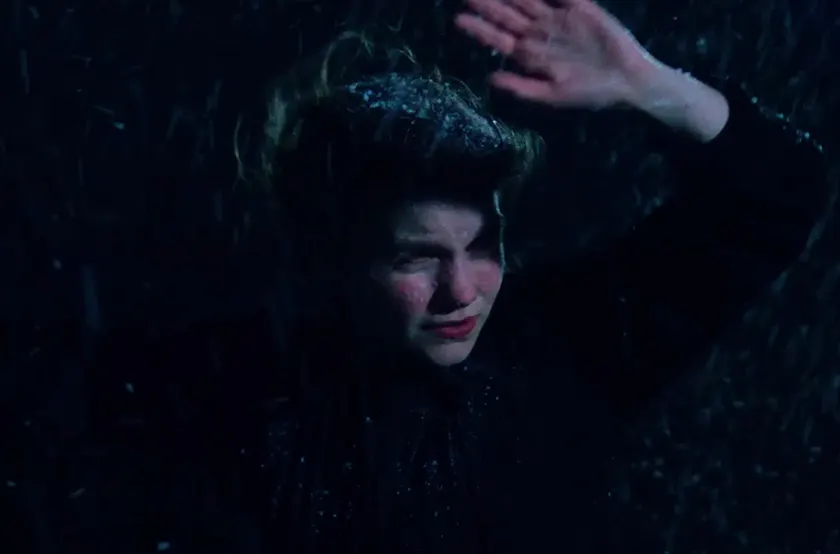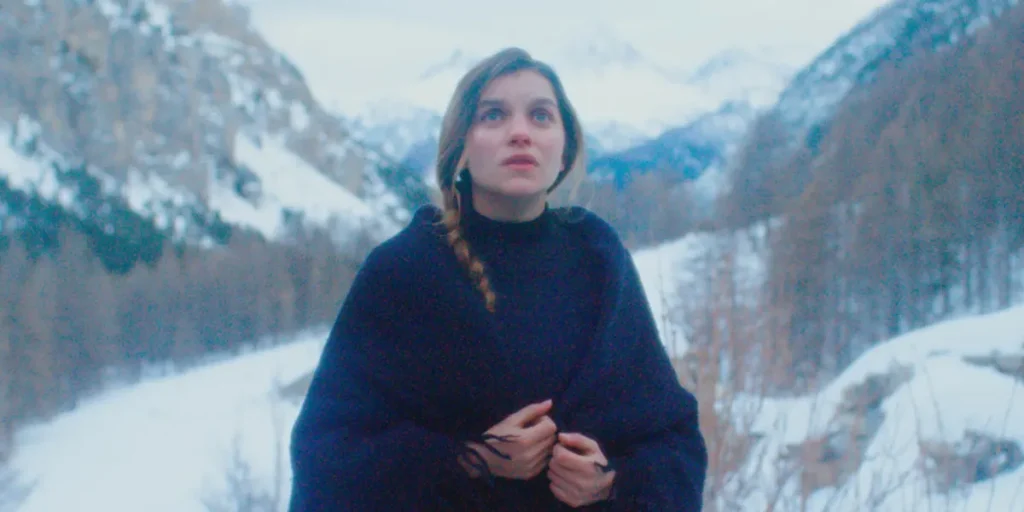In The Girl in the Snow, a young teacher fights the superstitions of a small hamlet in the snow-covered Alps, but when men start disappearing, suspicions arise.
Director: Louise Hémon
Original Title: L’Engloutie
Genre: Drama
Run Time: 98′
Cannes Premiere: May 15-17, 2025
Release Date: TBA
Where to watch: Théâtre Croisette, Alexandre III, Le Raimu, Le Licorne
The Girl in the Snow takes place in 1899 when young teacher Aimée (Galatea Bellugi, of The Taste of Things) visits a small hamlet for the winter. She’s staying in Soudain, which is located on a remote mountain in the Alps. Her goal is to educate the children of the settlement in order to widen their view of the world and give them the means to live a life that goes beyond the limitations of this reserved commune hiding between the mountains. It’s a bit ironic, then, that The Girl in the Snow fails to move past the framework established by other films before it.
Soudain comes with many superstitions and traditions that the elders seek to uphold. They get mad when Aimée gives the children a bath because the crust of dirt on their heads supposedly protects their brains. Aimée tells them that it’s important to bathe because the germs will only make them sick, but they refuse to listen. When a man dies, they make sure to leave the window open during his funeral so that his spirit can roam free. And when they realize they won’t be able to bury his body until summer due to the frozen ground, they strap the coffin onto the roof of Aimée’s house so he can hear the children play during the day.
Aimée tries to fight against the prevailing beliefs of the villagers with no success. When tradition has implanted itself into people’s minds, it’s hard to change their judgment. After all, that’s why Aimée is here: to impact the children before the superstitious elders can. But it’s not made easy for her. Even disregarding the differences in ideology, the elders aren’t happy to have a young person come in who thinks she knows better than they do. And with her being a woman, the predominantly male residents immediately take an interest in her, with some of them coming too close for comfort.
Those are the things The Girl in the Snow is interested in exploring: the superstitious beliefs and conservative values of secluded communities of the old times, and how they impact young people and women in particular. The film does that by incorporating light elements of folk horror. With the arrival of Aimée, weird things start to happen. The winter only gets harsher, avalanches hit nearby mountain slopes, and men start to disappear. All the while, the residents are giving her sinister looks.

In taking this approach, the film follows in the footsteps of a number of other movies from the past few years that can seemingly all be traced back to the success of The Witch in 2015. It has become a staple in the arthouse crowd since then, and you’ll find at least one of them in the festival circuit every year: it’s the beautifully shot and undeniably well-crafted uneasy period drama with glacial pacing and folk horror undertones that serve to highlight the treatment of women due to superstition and limited knowledge of the world in old times. It sounds super specific, but it has become very common in recent history. Last year it was The Devil’s Bath; this year, it’s The Girl in the Snow.
Such a specific trend forming in contemporary cinema doesn’t have to be a bad thing. In the ideal case, it allows different filmmakers to cast their own perspective onto a common framework that they can take in different directions as they see fit. Last year’s The Devil’s Bath managed to succeed exactly through that. Unfortunately, director Louise Hémon doesn’t do much with the structure other than to follow it dutifully. Making for a movie that feels very tired and lacking in creative ambition.
But it is admittedly well-made. The 4:3 cinematography by Marine Atlan stands out in particular: the icy landscapes and snow-covered forests are absolutely stunning. Long takes and an often static camera allow you to soak in every image. But technical expertise only gets you so far, and the most beautiful images can’t keep your attention forever if nothing else of interest is happening.
The Girl in the Snow (L’Engloutie): Movie Plot & Recap
Synopsis:
Aimée is a young teacher who stays in a small hamlet in the snow-covered Alps called Soudain. She’s there to educate the children, but the superstitious elders aren’t happy with what she’s teaching them. Then men start disappearing and all eyes are on Aimée.
Pros:
- Stunning 4:3 cinematography
- The snow-covered scenery is beautiful
Cons:
- It feels very derivative of other works
- Director Louise Hémon is unable to show her identity as a filmmaker
- Very slow pacing with little of interest happening to keep your attention
The Girl in the Snow (L’Engloutie) premiered at the Cannes Film Festival‘s Quinzaine des Cinéastes on May 15, 2025 and will be screened again at Théâtre Croisette, Alexandre III, Le Raimu, Le Licorne on May 15-17. Read our list of 20 movies to watch at the 2025 Cannes Film Festival!

